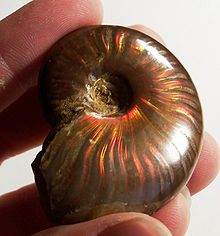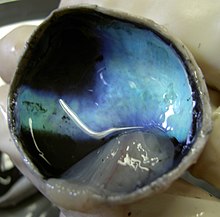Iridescence
It has been suggested that Cloud iridescence and Talk:Iridescence#Merger proposal be merged into this article. (Discuss) Proposed since April 2008. |



Iridescence is an optical phenomenon in which hue changes with the angle from which a surface is viewed. Iridescence may be easily seen in soap bubbles and butterfly wings.
Iridescence is caused by multiple reflections from multi-layered, semi-transparent surfaces in which phase shift and interference of the reflections modulates the incident light (by amplifying or attenuating some frequencies more than others). This process is the functional analog of selective wavelength attenuation as seen with the Fabry-Pérot interferometer.
Etymology
The word iridescence is derived in part from the Greek word iris (pl. irides), meaning "rainbow", which in turn derives from the goddess Iris of Greek mythology, who is the personification of the rainbow and acted as a messenger of the gods. Goniochromism is derived from the Greek words gonia, which means angle, and chroma, which means color.
Examples
Iridescence is the property of certain surfaces to change their colour depending on the angle under which they are viewed. From a physics standpoint this is rather uncommon behaviour, and in man-made objects this is usually only found in paints that are specifically designed for the effect. Examples are pearlescent paints or interference pigments, which are sometimes used for custom paintjobs on cars. Some specially woven fabrics or certain shampoos can also exhibit such behaviour. Natural examples of goniochromism can be found in the appearance of certain insects, such as the Morpho butterfly, whose metallic-looking wings exhibit a colour shift depending on the observation angle.

A very common and popular example is the inside of an abalone shell.
Under certain conditions, window film will exhibit iridescence. This phenomenon usually occurs at night, when the source of illumination within a building is fluorescent lighting.
The amount of iridescence may vary from almost imperceptible to very visible, and most frequently occurs when the film is constructed using one or more layers of sputtered metal, though it can occur in non-reflective films as well.
When iridescence does occur in window film, the only way to stop it is to prevent the fluorescent light from illuminating the film.

Taxonomically, the most widespread distribution of iridescent tissue in animals may be the tapetum lucidum, present in the eyes of many vertebrate animals.[citation needed]
Because the apparent image changes with the angle of observation, iridescence is not fully reproduced by conventional still image photography; however, it can be reproduced by holography (which includes phase information), and somewhat demonstrated by a video recording.
See also
External links
- Living photonic crystals
- A 2.2 MB GIF animation of a morpho butterfly showing iridescence
